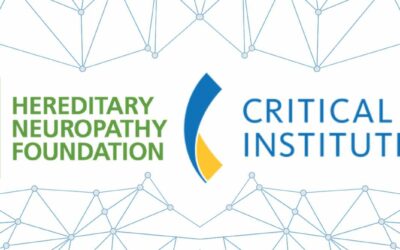 Interim Analysis from the Ongoing Open-Label Phase III Extension Study Shows Sustained Benefits of PXT3003 for Patients with Charcot-Marie-Tooth Disease Type 1A (‘CMT1A’)
Interim Analysis from the Ongoing Open-Label Phase III Extension Study Shows Sustained Benefits of PXT3003 for Patients with Charcot-Marie-Tooth Disease Type 1A (‘CMT1A’)
New results suggest good safety profile and sustained efficacy of PXT3003 as measured with the Overall Neuropathy Limitation Scale (‘ONLS’), after 4.5 years of total trial time.
A live conference call and webcast will be held tomorrow, Thursday April 29th at 2:00 p.m. CET (8:00 a.m. ET)
PARIS, France, April 28, 2021, 6:00 p.m. CET – Pharnext SA (FR0011191287 – ALPHA) (the ‘Company’), an advanced late-stage clinical biopharmaceutical company pioneering new approaches to developing innovative drug combinations based on big genomics data and artificial intelligence using its PLEOTHERAPY™ platform, today announces new results from an interim analysis of an ongoing open-label follow-up extension study (‘PLEO-CMT-FU trial’) following the first double-blind, placebo-controlled Phase III study (‘PLEO-CMT trial’) of PXT3003 for the treatment of Charcot-Marie-Tooth Disease Type 1A (‘CMT1A’). There is currently no approved drug treatment for CMT1A.
In January 2020, the company reported interim results suggesting sustained safety and efficacy of PXT3003 in patients with mild-to-moderate CMT1A after 24 months of total trial time (PLEO-CMT and PLEO-CMT-FU Period 1 trials). The new results announced today continue to show sustained treatment benefits for CMT1A patients treated with PXT3003 at High Dose (‘HD’) in the PLEO-CMT-FU Period 2 trial with a data readout at 54 months of total trial time (double-blind + open-label). Highlights from an analysis of available data include:
– PXT3003 was safe and well tolerated. Data are consistent with observed safety profile in prior clinical trials.
– Data on the Overall Neuropathy Limitations Scale (‘ONLS’), which measures patients’ functional motor disability, are as follows (please refer to the diagram below for graphical illustration):
o During PLEO-CMT (double-blind Phase III study), patients treated with placebo on average declined on ONLS while patients treated with PXT3003 on average improved. The best efficacy signal was observed in the cohort of patients treated with PXT3003 HD.
o During PLEO-CMT-FU (open-label Phase III Extension study), on average patients improved on ONLS across all patient cohorts.
- Patients treated with placebo declined on ONLS during the double-blind phase, but then improved when switched to PXT3003 in the ongoing open-label phase.
- Patients treated with PXT3003 during the double-blind phase continue to improve when pursuing their treatment with PXT3003 in the ongoing open-label phase.
– New results with available ONLS data after 54 months of total trial time suggest a better efficacy signal with PXT3003 HD in this patient population.
Adrian Hepner, MD, PhD, Chief Medical Officer of Pharnext, said: “Although these new data were generated from an open-label study, the findings are consistent with the safety and efficacy results of PXT3003 observed in prior clinical studies in CMT1A. In addition, the fact we have just initiated the PREMIER trial in a similar patient population, using the same High Dose of PXT3003 and measuring the same efficacy endpoint ONLS, reinforces our confidence in the potential positive outcome of our ongoing pivotal Phase III study”.
Florian P. Thomas, MD, PhD, Founding Chair & Professor, Department of Neurology, Hackensack University Medical Center & Hackensack Meridian School of Medicine (NJ, USA) and U.S. lead investigator of the PLEO-CMT trial, said: “These new results from the interim analysis of the ongoing open-label Phase III extension study show very promising safety and efficacy data of PXT3003 in CMT1A after more than four years of treatment. It reinforces our hope that PXT3003 could be the first treatment approved for patients suffering from this debilitating disease”.
“These new results from the interim analysis of the ongoing open-label Phase III extension study show very promising safety and efficacy data of PXT3003 in CMT1A after more than four years of treatment. It reinforces our hope that PXT3003 could be the first treatment approved for patients suffering from this debilitating disease”.
Results of First Double-Blind Phase III (PLEO-CMT) & Open-Label Extension (PLEO-CMT-FU) Studies of PXT3003 with an ONLS Data Readout at 54 Months of Total Trial Time
Conference Call Details
Pharnext will host a live conference call and webcast at 2:00 p.m. CET / 8:00 a.m. ET tomorrow Thursday April 29th, 2021 to discuss the data. The conference call may be accessed by dialing +33 (0)1 70 70 07 81 (France), +1 646 7413 167 (USA), or +44 (0) 2071 928338 (International) and using conference ID 6197704. The live webcast and accompanying slides can be accessed via the Pharnext’s website at https://pharnext.com/en in the ‘Events’ section or by clicking here. An archived webcast will then be available on the Pharnext’s website approximately 4 hours after the conference call.
About the PLEO-CMT Trial
The PLEO-CMT trial was an international, randomized, double-blind, placebo-controlled, Phase III study evaluating the efficacy and safety of PXT3003 in patients with CMT1A, over a 15-month period. Two dose levels, named low dose (‘LD’) and high dose (‘HD’), of PXT3003 in comparison to placebo were tested in patients diagnosed with mild-to-moderate CMT1A (HD equals double LD). A total of 323 patients were enrolled in 29 centers across Europe, the U.S. and Canada by December 2016 and last-patient-last-visit occurred in March 2018. Due to an unexpected issue in the HD formulation, the HD arm was prematurely stopped in September 2017. A revised statistical analysis plan was developed to take into account the premature HD arm discontinuation. Analysis of the primary endpoint, Overall Neuropathy Limitations Scale (‘ONLS’) from all investigated populations in the HD arm suggested preliminary efficacy in humans. The study further demonstrated the safety and tolerability of PXT3003. Further information on the PLEO-CMT trial, including study results, can be found on the ClinicalTrials.gov website (study identification number: NCT03023540) here.
About the PLEO-CMT-FU Trial
All randomized CMT1A patients who completed the PLEO-CMT trial (treated with PXT3003 or placebo) were eligible to pursue treatment with PXT3003 in the PLEO-CMT-FU trial. This trial enrolled a total of 187 patients and was designed to primarily assess the long-term safety and tolerability of PXT3003. It was initially planned to be a double-blind, nine-month, Phase III follow-up extension study where patients treated with PXT3003 in the PLEO-CMT trial were eligible to continue their treatment at the same dose (High dose ‘HD’ or Low Dose ‘LD’). Patients treated with placebo in the PLEO-CMT trial were randomized in PLEO-CMT-FU to receive LD or HD of PXT3003. Due to the PXT3003 HD formulation issue which occurred during the PLEO-CMT trial, the HD arm was discontinued in September 2017. Consequently, the PLEO-CMT-FU trial became an open-label study which is divided in 2 periods:
– Period 1 (9-month treatment period) from March 2017 to April 2019. Patients randomized to PXT3003 LD in PLEO-CMT continued on the same dose. Patients randomized to PXT3003 HD in PLEO-CMT continued on the same dose, but it was given as twice the volume of PXT3003 LD formulation after the PXT3003 HD formulation issue. Patients randomized to placebo in PLEO-CMT continued only on PXT3003 LD after the HD formulation issue.
– Period 2 from July 2018 (still on-going). The 153 patients who entered in PLEO-CMT-FU Period 2 were all switched to PXT3003 HD given as twice the volume of PXT3003 LD formulation.
In PLEO-CMT-FU, on top of safety and tolerability of PXT3003 which is evaluated every 3 months, long-term efficacy is evaluated with the Overall Neuropathy Limitations Scale (‘ONLS’) measured every 6 months. Results from the PLEO-CMT-FU trial will be reported on a yearly basis.
Further information on the PLEO-CMT-FU trial can be found on the ClinicalTrials.gov website (study identification number: NCT03023540) here.
About the PREMIER Trial
The PREMIER trial is an international, randomized, double-blind, two-arm placebo-controlled, pivotal Phase III study, evaluating the efficacy and safety of PXT3003 versus placebo in mild-to-moderate CMT1A patients, over a 15-month period. The dose of PXT3003 tested in the PREMIER trial corresponds to the high dose (‘HD’) tested in the prior Phase III trial (‘PLEO-CMT’). As agreed with regulatory agencies, the primary efficacy endpoint will be the Overall Neuropathy Limitations Scale (‘ONLS’) which measures functional motor disability. The secondary endpoints include the following outcome measures: 1) 10-Meter Walk Test (‘10mWT’), 2) Quantified Muscular Testing (bilateral foot dorsiflexion dynamometry), 3) Patient Global Impression of Severity (‘PGI-S’), 4) Patient Global Impression of Change (‘PGI-C’), 5) Charcot-Marie-Tooth Neuropathy Score, version 2 (‘CMTNS-v2’), and 6) Quantified Muscular Testing (hand grip). Safety and tolerability will be monitored throughout the study. Further information on the PREMIER trial can be found on the ClinicalTrials.gov website (study identification number: NCT04762758) here.
About Charcot-Marie-Tooth Disease Type 1A (‘CMT1A’)
Charcot-Marie-Tooth (‘CMT’) disease encompasses a heterogeneous group of inherited, severe, debilitating, progressive and chronic peripheral neuropathies. CMT1A, the most common type of CMT, is an orphan disease with a prevalence of 1/5000 people affecting about 150,000 people in Europe and the U.S. and about 1,500,000 people worldwide. The genetic mutation responsible for CMT1A is a duplication of the PMP22 gene coding for a peripheral myelin protein. The duplication of this gene results in overexpression of the PMP22 protein and failure of Schwann cells to produce normal myelin (neuronal sheath). The lack of a normal myelin structure and function leads to abnormal peripheral nerve conduction and axonal loss. As a result of peripheral nerve degradation, patients suffer from progressive muscle atrophy in both the legs and arms causing problems with walking, running and balance as well as abnormal hand functioning. They might also suffer from mild to moderate sensory disorders. First symptoms usually appear during adolescence and will progressively evolve throughout life. Patients with the most severe form of CMT1A end up in wheelchairs, representing at least 5% of cases. To date, no curative or symptomatic medications have been approved and treatment consists of supportive care such as orthotics, leg braces, physical and occupational therapy or surgery. More information can be found at https://pharnext.com/en/disease/charcot-marie-tooth.
About PXT3003
PXT3003 is a novel fixed-dose synergistic combination of baclofen, naltrexone and sorbitol formulated as an oral solution given twice a day. The three individual components of PXT3003 were selected to downregulate the overexpression of PMP22 protein, leading to improvement of neuronal signaling in dysfunctional peripheral nerves that are an essential part of the pathophysiology of this disease. PXT3003 could also have a positive effect on other cellular types of the motor unit such as the axon (direct protection), neuromuscular junctions or muscle cells. PXT3003 has shown promising and consistent results across preclinical and clinical studies in Phase II and Phase III (PLEO-CMT and PLEO-CMT-FU). More information can be found at https://pharnext.com/en/pipeline/pxt3003.
About Pharnext
Pharnext is an advanced clinical-stage biopharmaceutical company developing novel therapeutics for orphan and common neurodegenerative diseases that currently lack curative and/or disease-modifying treatments. Pharnext has two lead products in clinical development. PXT3003 completed an international Phase III trial with positive topline results for the treatment of Charcot-Marie-Tooth disease type 1A (‘CMT1A’) and benefits from orphan drug status in Europe and the United States. An international pivotal Phase III study of PXT3003 in CMT1A, the PREMIER trial, is currently ongoing. PXT864 has generated encouraging Phase II results in Alzheimer’s disease and will be advanced through partnerships. Pharnext has developed a new drug discovery paradigm based on big genomics data and artificial intelligence: PLEOTHERAPY™. Pharnext identifies and develops synergic combinations of drugs called PLEODRUG™. More information can be found at www.pharnext.com.
Pharnext is listed on the Euronext Growth Stock Exchange in Paris (ISIN code: FR0011191287).
Disclaimer
This press release contains certain forward-looking statements concerning Pharnext and its business, including in respect of timing of and prospects for clinical trials and regulatory submissions of the Company’s product candidates as well as a potential financing transaction, the use of proceeds therefrom and cash runway. Such forward-looking statements are based on assumptions that Pharnext considers to be reasonable. However, there can be no assurance that the estimates contained in such forward-looking statements will be verified, which estimates are subject to numerous risks including the risks set forth in Pharnext’s URD approved by the AMF on November 9, 2020 under number N° R. 20-029 as well as in its annual periodic management reports and press releases (copies of which are available on www.pharnext.com) and to the development of economic conditions, financial markets and the markets in which Pharnext operates. The forward-looking statements contained in this press release are also subject to risks not yet known to Pharnext or not currently considered material by Pharnext. The occurrence of all or part of such risks could cause actual results, financial conditions, performance or achievements of Pharnext to be materially different from such forward-looking statements. Pharnext disclaims any intention or obligation to publicly update or revise any forward-looking statements, whether as a result of new information, future events, or otherwise.
This press release and the information that it contains do not constitute an offer to sell or subscribe for, or a solicitation of an offer to purchase or subscribe for, Pharnext shares in any country, including the United States. The Company’s securities may not be offered or sold in the United States absent registration or an exemption from registration; any public offering of securities to be made in the United States will be made by means of a prospectus that may be obtained from the issuer that will contain detailed information about the Company and management, as well as financial statements.
The archived webcast and accompanying slides can be accessed via Pharnext’s website here.














0 Comments